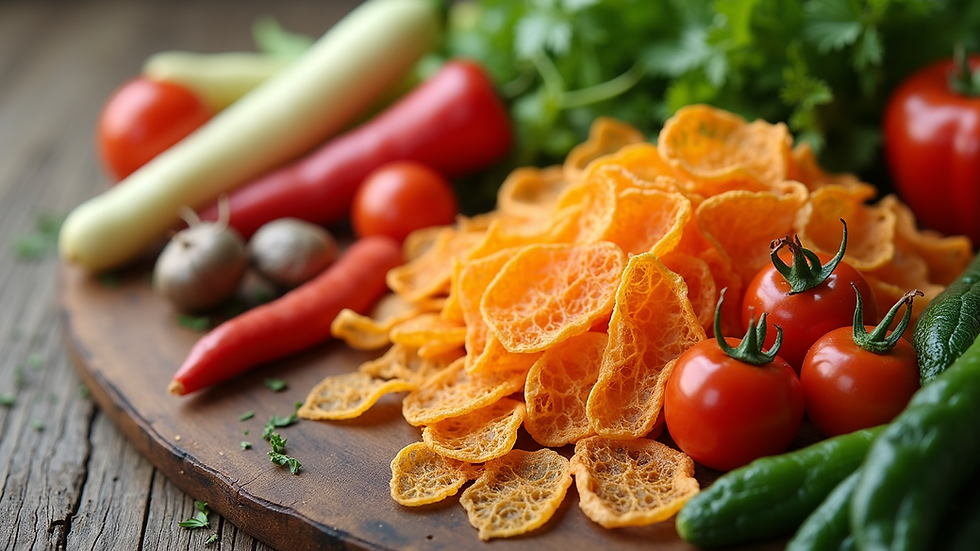Freeze Dried vs Dehydrated Foods A Comprehensive Comparison of Pros and Cons
- Aaron M.

- Aug 14
- 4 min read
In today’s world, food preservation has become more important than ever, especially for those who want to eat healthily and enjoy outdoor adventures. Freeze-drying and dehydrating are two popular methods for extending food shelf life while keeping essential nutrients intact. This blog post will break down the pros and cons of each method, guiding you in choosing what’s best for your needs.
What is Freeze-Drying?
Freeze-drying is a preservation technique that freezes food and reduces pressure, allowing the ice to turn into vapor. This method effectively retains the food’s structure, flavor, and nutritional value.
Pros of Freeze-Dried Foods
Nutrient Retention: Freeze-drying retains up to 97% of vitamins and minerals, making it one of the best options for maintaining nutritional value. For example, freeze-dried strawberries can preserve nearly all their vitamin C content.
Lightweight and Compact: Freeze-dried foods are about 90% lighter than their fresh counterparts. This makes them perfect for backpacking trips where every ounce counts.
Long Shelf Life: Properly stored freeze-dried foods can last for 25 years or more. This longevity makes them an excellent choice for emergency food supplies or long-term storage.
Rehydration Quality: Most freeze-dried foods rehydrate quickly. For instance, a freeze-dried meal can return to its original texture in just 5-10 minutes of soaking in water, often tasting similar to fresh food.
Cons of Freeze-Dried Foods
Cost: The freeze-drying process is more expensive, which often translates to a higher price tag. For example, a bag of freeze-dried apples may cost two to three times more than dehydrated apples.
Texture Changes: While flavors are well-preserved, the texture can differ from fresh produce. Some consumers find freeze-dried snacks like fruits to be crunchier than they prefer.
Limited Availability: Not all foods can undergo freeze-drying, and options in stores may not be diverse. You will typically find fruits, vegetables, and certain meals available, but your favorite snacks may be missing.
What is Dehydrating?
Dehydrating reduces moisture from food using heat and airflow. This can be done in a dehydrator, oven, or even through sunlight exposure. The result is often a chewier product with a strong flavor.
Pros of Dehydrated Foods
Cost-Effective: Dehydrating is generally more affordable than freeze-drying, making it accessible to more people. You can easily dehydrate fruits at home for a fraction of the cost of store-bought freeze-dried alternatives.
Variety of Foods: Almost any food can be dehydrated, from apples to beef jerky. For instance, you can make a diverse selection of snacks like zucchini chips and banana crisps.
Simple Process: Dehydrating can be done at home with limited equipment. A basic dehydrator can be purchased for around $50, making it achievable for budget-conscious individuals.
Flavor Concentration: The dehydration process enhances flavors, making foods more intense. For example, dehydrated tomatoes are bursting with taste and can elevate many dishes.
Cons of Dehydrated Foods
Nutrient Loss: Some vitamins, especially heat-sensitive ones like vitamin C, can be reduced by 10-30% during dehydration. This means you might not be getting all the nutrients you expect.
Longer Rehydration Time: Rehydrating dehydrated foods typically takes longer, often needing 30 minutes to an hour, which could be inconvenient when you’re in a hurry.
Shelf Life: Dehydrated foods usually last 1 to 5 years, depending on storage conditions and types of food. For instance, dried fruits might spoil quicker than dehydrated meats.
Freeze-Dried vs Dehydrated: A Side-by-Side Comparison
| Feature | Freeze-Dried Foods | Dehydrated Foods |
|-------------------------------- |-------------------------------------- |-------------------------------------- |
| Nutrient Retention | Up to 97% | 70-90% |
| Cost | Higher | Lower |
| Shelf Life | 25+ years | 1-5 years |
| Rehydration Time | 5-10 minutes | 30-60 minutes |
| Texture | Closer to fresh | Chewy |
| Variety | Limited | Extensive |
Which is Better for You?
Choosing between freeze-dried and dehydrated foods comes down to what matters most for your lifestyle. If you focus on nutrient retention and want food that lasts for a long time, freeze-dried may be your best bet. However, if cost and variety are your priorities, dehydrated foods might better fit your needs.
Consider Your Lifestyle
For hiking or camping, freeze-dried meals are convenient and light. For those who love cooking at home, experimenting with dehydrating might be an enjoyable hobby that lets you get creative with flavors and snacks.
Health Considerations
If you’re aiming to maintain a balanced diet, freeze-dried foods may give you an edge nutritionally. Incorporating both freeze-dried and dehydrated options into your diet can enhance the variety of healthy foods you consume.
Final Thoughts
Both freeze-dried and dehydrated foods have unique benefits and drawbacks. By understanding their differences, you can make a better choice based on your lifestyle, budget, and health needs. Whether you opt for freeze-dried or dehydrated foods, each method provides valuable options for preserving food and maintaining access to healthy meals any time.






Comments